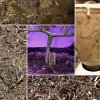I would topdress with some worm castings myself and feed some fish hydroslate. Wait I have a post for this

.
NPK values
Alfalfa Hay: 2.45/05/2.1
Apple Fruit: 0.05/0.02/0.1
Apple Leaves: 1.0/0.15/0.4
Apple Pomace: 0.2/0.02/0.15
Apple skins(ash) : 0/3.0/11/74
Banana Residues (ash): 1.75/0.75/0.5
Barley (grain): 0/0/0.5
Barley (straw): 0/0/1.0
Basalt Rock: 0/0/1.5
Bat Guano: 5.0-8.0/4.0-5.0/1.0
Beans, garden(seed and hull): 0.25/0.08/03
Beet Wastes: 0.4/0.4/0.7-4.1
Blood meal: 15.0/0/0
Bone Black: 1.5/0/0
Bonemeal (raw): 3.3-4.1/21.0/0.2
Bonemeal (steamed): 1.6-2.5/21.0/0.2
Brewery Wastes (wet): 1.0/0.5/0.05
Buckwheat straw: 0/0/2.0
Cantaloupe Rinds (ash): 0/9.77/12.0
Castor pomace: 4.0-6.6/1.0-2.0/1.0-2.0
Cattail reeds and water lily stems: 2.0/0.8/3.4
Cattail Seed: 0.98/0.25/0.1
Cattle Manure (fresh): 0.29/0.25/0.1
Cherry Leaves: 0.6/0/0.7
Chicken Manure (fresh): 1.6/1.0-1.5/0.6-1.0
Clover: 2/0/0/0 (also contains calcium)
Cocoa Shell Dust: 1.0/1.5/1.7
Coffee Grounds: 2.0/0.36/0.67
Corn (grain): 1.65/0.65/0.4
Corn (green forage): 0.4/0.13/0.33
Corn cobs: 0/0/2.0
Corn Silage: 0.42/0/0
Cornstalks: 0.75/0/0.8
Cottonseed hulls (ash): 0/8.7/23.9
Cottonseed Meal: 7.0/2.0-3.0/1.8
Cotton Wastes (factory): 1.32/0.45/0.36
Cowpea Hay: 3.0/0/2.3
Cowpeas (green forage): 0.45/0.12/0.45
Cowpeas (seed): 3.1/1.0/1.2
Crabgrass (green): 0.66/0.19/0.71
Crabs (dried, ground): 10.0/0/0 (I personally just crush the shells with my foot)
Crabs (fresh): 5.0/3.6/0.2
Cucumber Skins (ash): 0/11.28/27.2 ( WOW!!!! Who knew
)
Dried Blood: 10.0-14.0/1.0-5.0/0
Duck Manure (fresh): 1.12/1.44/0.6
Eggs: 2.25/0.4/0.15
Eggshells: 1.19/0.38/0.14
Feathers: 15.3/0/0
Felt Wastes: 14.0/0/1.0
Field Beans (seed): 4.0/1.2/1.3
Feild Beans (shells): 1.7/0.3/1.3
Fish (dried, ground): 8.0/7.0/0
Fish Scraps (fresh): 6.5/3.75/0
Gluten Meal: 6.4/0/0
Granite Dust: 0/0/3.0-5.5
Grapefruit Skins (ash): 0/3.6/30.6 (And people throw these things away? Wow!)
Grape Leaves: 0.45/0.1/0.4
Grape Pomace: 1.0/0.07/0.3
Grass (imature): 1.0/0/1.2
Greensand: 0/1.5/7.0
Hair: 14/0/0/0
Hoof and Horn Meal: 12.5/2.0/0
Horse Manure (fresh): 0.44/0.35/0.3
Incinerator Ash: 0.24/5.15/2.33
Jellyfish (dried): 4.6/0/0 (Incidentally, I don't dry mine before adding them to the pile)
Kentucky Bluegrass (green): 0.66/0.19/0.71
Kentucky Bluegrass (hay): 1.2/0.4/2.0
Leather Dust: 11.0/0/0
Lemon Culls: 0.15/0.06/0.26
Lemon Skins (ash): 06.33/1.0
Lobster Refuse: 4.5/3.5/0
Milk: 0.5/0.3/0.18
Millet Hay: 1.2/0/3.2
Molasses Residue
(From alcohol manufacture): 0.7/0/5.32
Molasses Waste
(From Sugar refining): 0/0/3.0-4.0
Mud (fresh water): 1.37/0.26/0.22
Mud (harbour): 0.99/0.77/0.05
Mud (salt): 0.4.0/0
Mussels: 1.0/0.12/0.13
Nutshells: 2.5/0/0
Oak Leaves: 0.8/0.35/0.2
Oats (grain): 2.0/0.8/0.6
Oats (green fodder): 0.49/0/0
Oat straw: 0/0/1.5
Olive Pomace: 1.15/0.78/1.3
Orange Culls: 0.2/0.13/0.21
Orange Skins: 0/3.0/27.0 (Right up there with Grapefruit. Note: both can attract fruit flies so, bury them in the compost)
Peach Leaves: 0.9/0.15/0.6
Pea forage: 1.5-2.5/0/1.4
Peanuts (seed/kernals): 3.6/0.7/0.45
Peanut Shells: 3.6/0.15/0.5 (I grind them up in the food processor first)
Pea Pods (ash): 0/3.0/9.0 (I cut them up with a pair of scissors while shelling them)
Pea (vines): 0.25/0/0.7
Pear Leaves: 0.7/0/0.4
Pigeon manure (fresh): 4.19/2.24/1.0
Pigweed (rough): 0.6/0.1/0
Pine Needles: 0.5/0.12/0.03
Potato Skins (ash): 0/5.18/27.5
Potaote Tubers: 0.35/0.15/2.5
Potatoe Vines (dried): 0.6/0.16/1.6
Prune Refuse: 0.18/0.07/0.31
Pumpkins (fresh): 0.16/0.07/0.26
Rabbitbrush (ash): 0/0/13.04
Rabbit Manure: 2.4/1.4/0.6
Ragweed: 0.76/0.26/0
Rapeseed meal: 0/1.0=2.0/1.0=3.0
Raspberry leaves: 1.45/0/0.6
Red clover hay: 2.1/0.6/2.1
Redrop Hay: 1.2/0.35/1.0
Rock and Mussel Deposits From Ocean: 0.22/0.09/1.78
Roses (flowers): 0.3/0.1/0.4
Rye Straw: 0/0/1.0
Salt March Hay: 1.1/0.25/0.75
Sardine Scrap: 8.0/7.1/0
Seaweed (dried): 1.1-1.5/0.75/4.9 (Seaweed is loaded with micronutrients including: Boron, Iodine, Magnesium and so on.)
Seaweed (fresh): 0.2-0.4/0/0
Sheep and Goat Manure (fresh): 0.55/0.6/0.3
Shoddy and Felt: 8.0/0/0
Shrimp Heads (dried): 7.8/4.2/0
Shrimp Wastes: 2.9/10.0/0
Siftings From Oyster Shell Mounds: 0.36/10.38/0.09
Silk Mill Wastes: 8.0/1.14/1.0
Silkworm Cocoons:10.0/1.82/1.08
Sludge: 2.0/1.9/0.3
Sludge (activated): 5.0/2.5-4.0/0.6
Smokehouse/Firepit Ash:0/0/4.96 (I put the ashes from my smoker in the pile)
Sorghum Straw:0/0/1.0
Soybean Hay: 1.5-3.0/0/1.2-2.3
Starfish: 1.8/0.2/0.25 (I'm not saying: "Go out and decimate starfish populations at our local beaches" but, the odd starfish would be okay. Incidentally, the edndoskeletons of starfish are made of Calcium Carbonate which, is slow to break down.)
String Beans (strings and stems, ash): 0/4.99/18.0 (Why we throw this stuff away? I have no idea. Look at all that potash!)
Sugar Wastes (raw): 2.0/8.0/0
Sweet Potatoes: 0.25/0.1/0.5
Swine Manure (fresh): 0.6/0.45/0.5
Tanbark Ash: 0/0.34/3.8
Tanbark Ash (spent): 0/1.75/2.0
Tankage: 3.0-11.0/2.0-5.0/0
Tea Grounds: 4.15/0.62/0.4
Timothy Hay: 1.2/0.55/1.4
Tobacco Leaves: 4.0/0.5/6.0
Tobacco Stems: 2.5-3.7/0.6-0.9/4.5-7.0
Tomatoe Fruit: 0.2/0.07/0.35 (A note on tomatoe fruit: These should be hot composted. I just let any rotted or insect eaten tomatoes compost in the soil beneath the plants and have "freebees" come back each consecutive year. Hot composting will kill the seeds.)
Tomatoe Leaves: 0.35/0.1/0.4
Tomatoe Stalks: 0.35/0.1/0.5
Tung Oil Pumace: 6.1/0/0
Vetch Hay: 2.8/0/2.3
Waste Silt: 9.5/0/0
Wheat Bran: 2.4/2.9/1.6
Wheat (grain): 2.0/0.85/0.5
Wheat Straw: 0.5/0.15/0.8
White Clover (Green): 0.5/0.2/0.3
Winter Rye Hay: 0/0/1.0
Wood Ash: 0/1.0-2.0/6.0-10.0 (A note on Wood ash: Wood Ash can contain chemicals that could harm plants and also carcinogens so, they should be composted in moderation)
Wool Wastes: 3.5-6.0/2.0-4.0/1.0-3.5



 then mixed in some compost and EWC. I then mixed in the shredded spruce parts and a couple handfuls of coco-coir
then mixed in some compost and EWC. I then mixed in the shredded spruce parts and a couple handfuls of coco-coir 